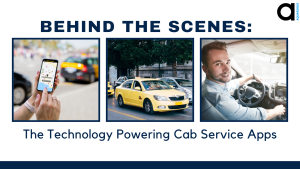Behind the Scenes: The Technology Powering Cab Service Apps

In today’s fast-paced world, getting from point A to point B has become more convenient and efficient. The commendable technological strides have spearheaded a transformative revolution in the cab service application domain, fundamentally altering human mobility dynamics. Whether one seeks to embark on a journey to the airport, partake in a nocturnal escapade, or engage in the daily commute to their occupational abode, these digital platforms have seamlessly ingrained themselves into the fabric of our quotidian existence. But have you ever wondered what goes on behind the scenes to make these apps work seamlessly? Hire Android app developer to make your budding can service viral.
Evolution of Cab Service Apps
Let’s first explore the technological development of cab service apps to comprehend it. In the past, contacting a taxi dispatch centre or waving your hand at a street corner were the only options for hailing a cab. This procedure could have been more convenient and reliable. However, the landscape of the transportation business witnessed a significant upheaval with the introduction of ride-hailing apps like Uber and Lyft.
These apps used the capabilities of cell phones, GPS, and the internet to match passengers with drivers who were available instantly. The time of hailing a cab was over; now, a few touches on your smartphone screen may call a driver to your position. Due to its practicality, efficiency, and simplicity of use, this revolutionary innovation immediately acquired acceptance.
Critical Components of Cab Service Apps
A well-designed architecture with several vital components is at the heart of every successful cab service app. Let’s explore these components’ crucial role in ensuring a seamless user experience.
1. User Interface
A user-friendly interface is crucial for both passengers and drivers to have a seamless and intuitive experience. The app’s interface should be pleasing to the eye, simple to use, and responsive on various devices. Clear icons, organised menus, and simple controls facilitate a great user experience. Hire android app developer from the best mobile app development company for best results.
2. Geolocation and Mapping
Geolocation and mapping technologies form the foundation of cab service apps. By integrating GPS capabilities, these apps can pinpoint a user’s location and match them with the closest available driver. Navigation is seamless and effective thanks to real-time mapping tools that provide precise route computations and turn-by-turn directions.
3. Real-time Data
Cab service apps rely on real-time data processing to facilitate real-time communication and updates. This enables drivers and passengers to track each other’s locations, estimate arrival times, and monitor traffic conditions. Real-time data ensures transparency and enhances the overall user experience.
4. Payment Integration
The seamless integration of payments is a crucial element of cab service apps. Cash transactions are being phased out in favour of digital payments in the current digital era. Apps for cab services include safe and practical payment methods, including credit/debit card purchases, mobile wallets, and even PayPal integration. With no need to carry cash or deal with change, travellers can pay for their rides quickly.
Matching Algorithms
One of the critical challenges for cab service apps is efficiently matching passengers with available drivers. To tackle this, sophisticated matching algorithms are employed. These algorithms consider proximity, driver availability, passenger preferences, and even driver ratings to optimise the matching process. These algorithms minimise wait times and enhance the overall user experience by ensuring efficient pairings.
1. Efficient driver-passenger pairing
Matching algorithms analyse many data points in real-time to find the most suitable driver for a passenger’s request. Factors such as proximity, driver availability, and even historical data are considered to ensure quick and efficient pairings. This improves response times and reduces passenger wait times.
2. Optimising route planning
Cab service apps aim to provide passengers with the fastest and most cost-effective routes to their destinations. To determine the best way for each ride, sophisticated route optimisation algorithms consider traffic conditions, road closures, and even real-time data. These algorithms improve productivity and consumer satisfaction by minimising trip time and distance.
Push Notifications and Communication
Effective communication between drivers and passengers is essential for a smooth ride experience. Cab service apps utilise push notifications and in-app messaging to facilitate real-time communication. Passengers receive updates on driver arrival, estimated arrival time, and other important trip details. Similarly, drivers can communicate with passengers regarding pickup locations or any necessary information. Push notifications ensure that both parties stay informed throughout the ride.
Rating and Feedback Systems
Apps for cab services include rating and feedback systems to maintain good service standards. After each trip, customers can comment on the overall experience and score their driver’s performance. Accountability and quality control are enhanced as a result. To create a fair and open ecology, drivers can also rate passengers. The ratings and comments improved service quality and fostered user confidence among app users.
Safety and Security Features
Safety is of paramount importance in the transportation industry. Cab service apps have implemented safety and security features to protect passengers and drivers.
1. Driver and passenger verification
To establish trust and security, cab service apps verify the identity of both drivers and passengers. Drivers undergo thorough background checks, including criminal record checks and driver’s license verification. Passengers can also view the driver’s profile, including their photo and ratings, before accepting a ride. This verification process ensures a safer experience for everyone involved.
2. Emergency assistance
Cab service apps have integrated emergency assistance features to handle critical situations. Passengers can access emergency services directly from the app, and drivers are equipped with emergency contact information. These features provide an additional layer of security and peace of mind for both passengers and drivers.
Scalability and Performance
Cab service apps must handle many simultaneous requests while maintaining high performance. Scalability is crucial in ensuring the app can drive increasing user demand. By leveraging cloud computing resources, cab service apps can scale their infrastructure dynamically, accommodating spikes in usage and providing a seamless experience even during peak hours.
Backend Infrastructure
Behind the scenes, cab service apps rely on robust backend infrastructure to support their operations. This infrastructure comprises several components that work together to deliver a reliable and efficient service.
1. Cloud computing
Cab service apps leverage cloud computing to store and process data securely. Cloud platforms provide scalability, high availability, and fault tolerance, ensuring the app can handle the ever-increasing volume of data without compromising performance.
2. Database management
Efficient database management is crucial for storing and retrieving user data, ride history, driver information, and other relevant data points. Cab service apps utilise database management systems to ensure data integrity, quick access, and efficient query processing.
3. API integration
APIs (Application Programming Interfaces) enable seamless integration with external services, such as payment gateways, mapping services, and third-party applications. Cab service apps rely on API integration to provide users with a comprehensive and connected experience.
Future Trends and Innovations
The world of cab service apps is constantly evolving, and new technologies continue to shape the industry. Here are some future trends and innovations to look out for:
1. Autonomous vehicles
The rise of autonomous vehicles holds immense potential for the cab service industry. Self-driving cars could revolutionise transportation, providing safer and more efficient rides. Cab service apps are likely to integrate autonomous vehicles into their fleets, offering passengers a glimpse into the future of transportation.
2. Integration with other services
Cab service apps are expanding their offerings by integrating with other services. This includes partnerships with food delivery services, parcel delivery companies, and public transportation networks. The aim is to provide users with a comprehensive platform that caters to all their transportation needs.
3. Artificial Intelligence and Machine Learning
Technologies like artificial intelligence (AI) and machine learning (ML) are increasing in cab service apps. These technologies can analyse enormous amounts of data to improve user experience, enhance matching algorithms, forecast demand, and optimise routes. The future of cab service apps will be shaped by AI and ML, which will continue to spur innovation. Hire Android app developer who keeps themself up to date with the latest technological innovations.
Conclusion
Behind the scenes, cab service apps rely on sophisticated technology, algorithms, and infrastructure to provide users with seamless and convenient transportation experiences. These apps have transformed how we travel from user-friendly interfaces to geolocation and mapping, real-time data processing, and secure payment integration. As technology advances, we expect even more exciting developments and innovations in the cab service industry.
If you want to build an app for your budding cab service, hire Android app developer from Aquarious Technology! Contact us to learn more.
-
14
+Category
-
98
+Post
Top Categories
Popular Posts
- The Power of Prototyping in Software Development
- Version Control Best Practices for App Development
- Understanding Visual Hierarchy: A Guide to Effective Design
- Crafting Intuitive Navigation: A Guide to Seamless User Experience
- Choose Your Best Cloud Provider
- Making the Leap: Transitioning from Manual to Automated Software Testing
- Using GitHub- Advantages and Disadvantages
- E-commerce Product Photography on a Budget
- Tech Innovation in Developing Countries
- Smart Cities: How Technology is Shaping the Urban Landscape
- Principles of Composition: Creating Visual Harmony with Composition
- Exploring Cross-Platform App Development
- Why Regular Website Updates Matter
- Navigating Effective Facebook Audience Targeting
- Implementing Ads for Game Monetization
- Designing User-Centric Mental Health Apps: Enhancing Well-being in the Digital Age
- NFTs and Collectibles: Creating NFT App Solutions for Collectors and Enthusiasts
- Successful Implementation of Enterprise Apps
- Maximizing Business Impact with EQ
- Proven SMO Ads Optimization Tips (2023)






